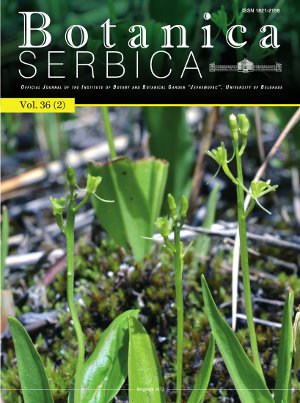
Volume 36 Issue 2 2012 |
Variations in some quality attributes of air-dried fruit of two apple cultivars from Iran
|
KEY WORDS: apple, HPLC, anthocyanin, flavonoid, phenolic compounds |
Qualitative properties of Melissa officinalis after the application of Rastim 30 DKV
|
KEY WORDS: Melissa officinalis L., essential oil, ontogenesis, leaf inserts, Rastim 30 DKV [ 3-(benzyloxycarbonyl-methyl)-2-benzothiazolinone |
Liparis loeselii(L.) Rich. – a plant rediscovered in the Balkan peninsula
|
KEY WORDS: Liparis loeselii, new record, endangered species, Balkan Peninsula, Bosnia and Herzegovina, Livanjsko polje |
Biochemical Analysis of Some Brown Seaweeds from the Aegean Sea
|
KEY WORDS: Brown algae, protein assay, total phenolic content, total sugar |
Effects of some growth regulators on oil yield, growth and hormonal content of lemon grass (Cymbopogon citrates)
|
KEY WORDS: Lemongrass, indole butyric acid, mepiquat chloride, phytohormones, oil, yield |
Leaf anatomical study of taxons Salvia nemorosa subsp. tesquicola, Salvia nutans, and Salvia × Sobrogensis from Dobrudja
|
KEY WORDS: anatomy, leaf, Salvia species. |
First record of vivipary in a species of the genus Sesleria (Poaceae)
|
KEY WORDS: vivipary, induced pseudo-vivipary, Poaceae, Sesleria |
Evaluation of phenolic content and antioxidant capacity in some medicinal herbs cultivated in Iran
|
KEY WORDS: total phenolic content, antioxidant capacity, Lamiaceae |
Improved alkaloid content in callus culture of Catharanthus roseus
|
KEY WORDS: Catharanthus roseus, callus culture, leaf callus, callus biomass, alkaloid. |
The sinstructure of epiphytic lichens within forests from the eastern part of Bucharest Municipality (Romania)
|
KEY WORDS: epiphytic lichen, sinstructure, forests, Bucharest Municipality, Romania |
Distribution of Lunaria telekiana (Brassicaceae), a poorly known species of European concern
|
Although of great international significance, the distribution of L. telekiana is only poorly known, without any georeferenced records on GBIF. Except for the locus classicus “Škelsen ad pagum Tropoja”, as well as localities “Bajram Curri” and “Maja e Hekurave” in Albania, all other published and unpublished data on the distribution of this species are largely unknown. Based on several years of field studies, analyses of herbarium and literature data, the authors managed to record the occurrence of L. telekiana in Albania, Montenegro and Serbia, and to outline its distribution range more precisely. The size of plant populations at the studied localities and new threatened status according to criteria and categories of IUCN have been established individually for Europe, Albania, Montenegro and Serbia. KEY WORDS: Lunaria, endemic species, critically endangered species, distribution, Balkan Peninsula |
Jacobaea vulgaris subsp. gotlandica (Compositae), new for Italy and Montenegro
|
KEY WORDS: Jacobaea vulgaris subsp. gotlandica, Italy, Montenegro, distribution |
Professor Dr Dragoljub Grubišic (1946-2011) |


